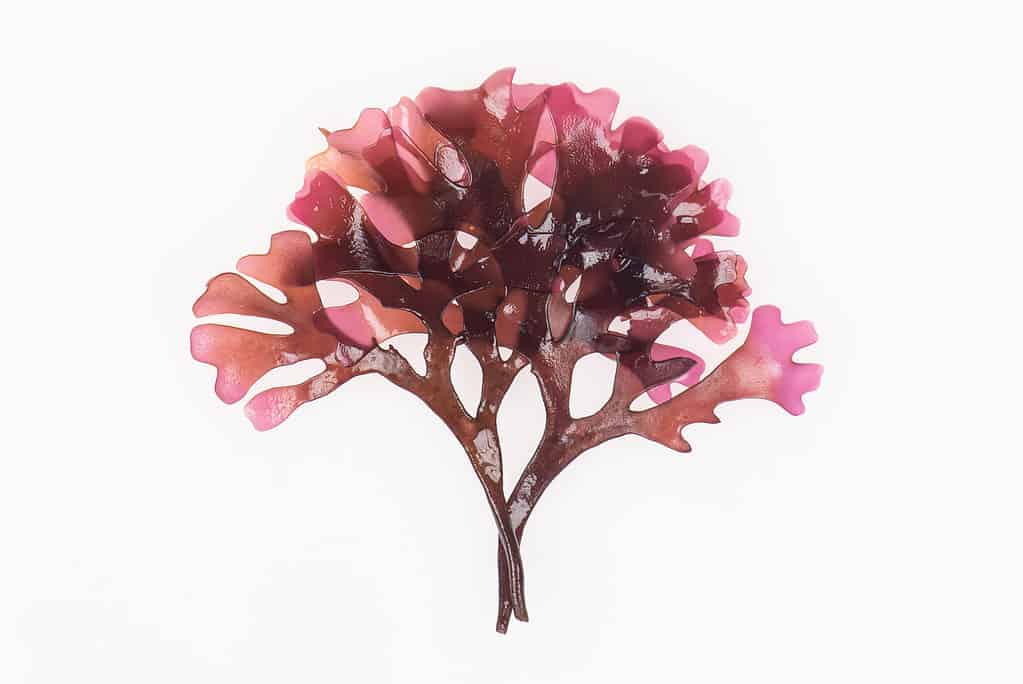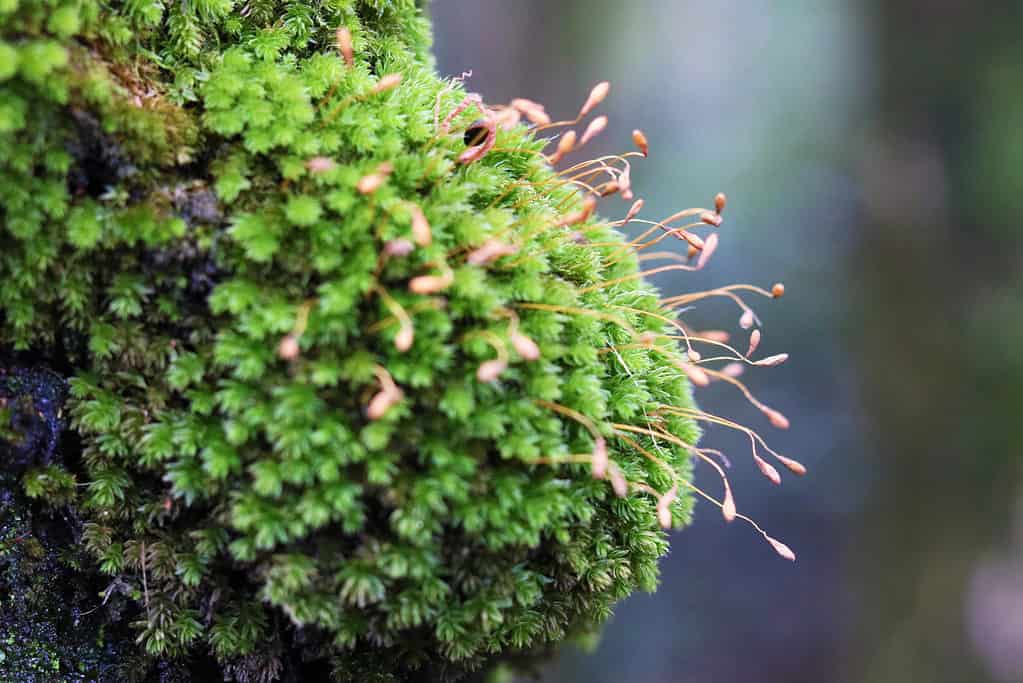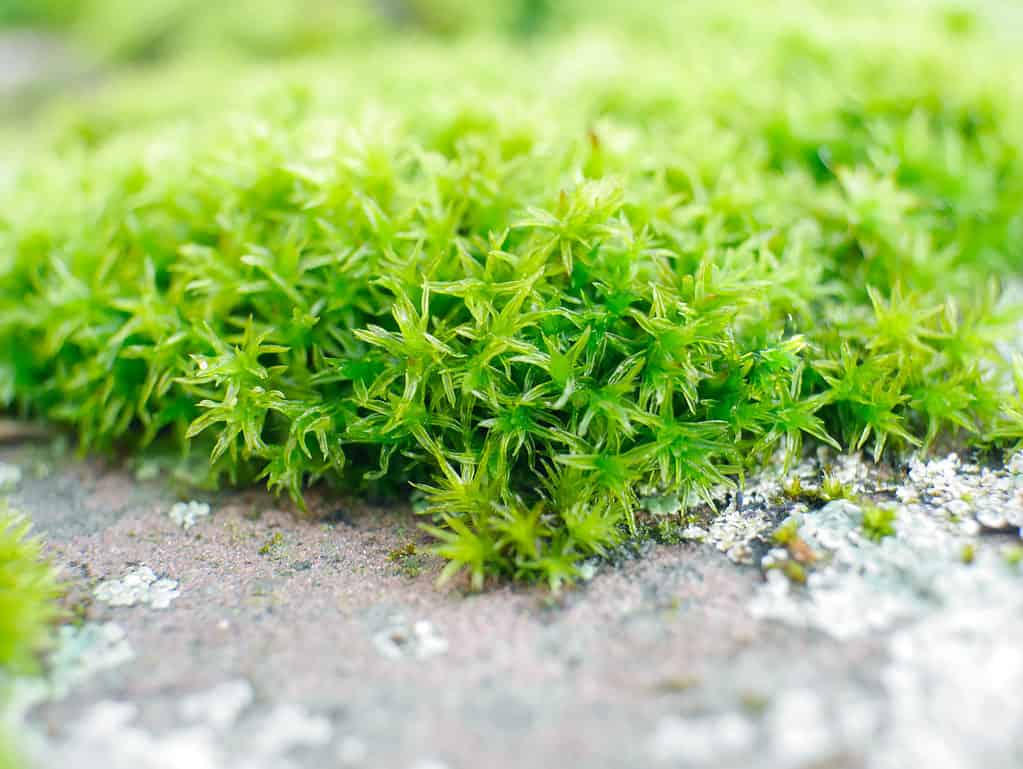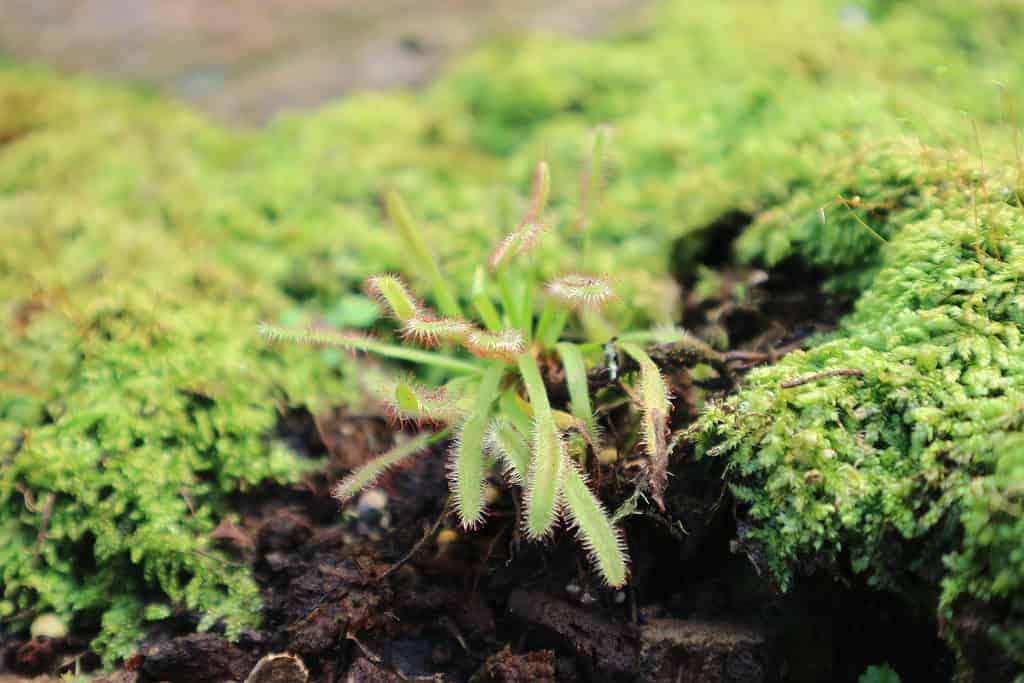Hear ye, Hear ye! Today the court will be weighing the evidence in the case of Scotch moss vs. Irish moss. We’ll I.D. the perps, checking on any aliases they might have. Then we’ll look into their origins and growing habits, before discussing means of propagation.
The jury has been seated, the judge (that’s you!) is on the bench, and the evidence has been gathered. So, without further ado, let’s learn how these plants are similar and how they differ.
Scotch Moss vs. Irish Moss: Comparison
| Scotch Moss | Irish Moss | |
|---|---|---|
| Botanical Name: | Arenaria verna | Sagina subulata |
| Other Names: | moss sandwort, Scottish moss | heath pearlwort, awl-leaf pearlwort, Sottish moss |
| Description: | yellow-green moss-like foliage; grows to 2 inches tall with 8 inch spread; tiny white flowers mid to late summer. | deep-green moss-like foliage; grows to 1 inch tall with 12 inch spread; tiny, lightly scented, white flowers in spring |
| USDA Growing Zones: | Zones 4-7 | Zones 4-8 |

Scotch moss produces tiny white flowers in te summer.
©speakingtomato/Shutterstock.com
What’s in a Name?
Have you ever done an internet search of your first and last names? If you have, chances are, you were surprised to learn that your first and last name combination is not nearly as unique as you thought. Even uncommon names.
Take the case of the Bradys Feigl. There are (at least) two of them. They both have red hair. They both play professional baseball. But until someone started compiling statistics in the baseball world, the one Brady Feigl was completely unaware of the existence of the other Brady Feigl. And vice versa. They took a DNA test; turns out they’re not related.
So it goes with Scotch moss and Irish moss.
Irish Moss can refer to Sagina subulata, the type we will be discussing here, but it can also refer to Chondrus crispus, a species of red algae that grows along rocky portions of the Atlantic Coasts in North America and Europe. The two separate species are not related.

Irish moss is also a species of red algae that grows along rocky coastlines.
©HedvikaMichnova.jpg/Shutterstock.com
On the other hand, Scotch moss seems to have a more unique name, in that no unrelated plant forms are called Scotch moss. Sagina subulata ‘Aurea’ is a cultivar of Irish moss, that is referred to as Scottish moss or Scotch moss, true Scotch moss (Arenaria verna), often gets called by other names. Chief among them? Irish moss!
Names and Misnomers
Since we’re on the subject of names, It should be pointed out that while they have the word moss in their names, it’s a misleading misnomer, as neither Arenaria verna nor Sagina subulata are actually moss (Bryophyta). The defining characteristic that sets Scotch moss and Irish moss apart from true moss is their flowering habit. True moss does not flower, reproducing via spoors, instead of seed. However, as we will learn, Scotch moss and Irish moss do flower and are grown from the resulting seed.

True moss, pictured, does not flower, reproducing via spoors, instead of seed.
©Gaian child/Shutterstock.com
With that in mind, let’s delve into the similarities and differences between these two flowering perennials from the carnation family.
Scotch Moss vs. Irish Moss: General Description
Scotch moss (Arenaria verna) and Irish moss (Sagina subulata) are herbaceous prostrate evergreen perennials. But what does that string of words even mean? Let’s break it down:
Herbaceous refers to plants that have no woody stems above the ground. Examples include root vegetables (potatoes, carrots, beets, etc.), most ferns, and all true grasses.
Prostrate plants characteristically grow and spread along the ground horizontally, rather than growing upright and vertically. Dichondra (pony’s foot), Vinca (periwinkle), Thymus serpyllum (creeping thyme), and Phlox, are examples of prostrate plants.

Scotch moss and Irish moss are herbaceous prostrate evergreen perennials.
©Janda/Shutterstock.com
Evergreens are plants that keep their leaves year-round. The foliage also stays green. Think pine trees and junipers.
Perennial plants will return in the springtime, year after year, unlike annuals, which complete their life cycle in one year, requiring reseeding or replanting (bedding plants that were grown from seed) every spring. One other class of plants, biennials, grow stems and leaves in the first year, developing flowers, fruit, and seed in the second year.
So, a herbaceous prostrate evergreen perennial, in layman’s terms, is a plant with no woody steams, spreading along the ground while retaining its foliage year-round, that does not require replanting in the spring.
So, what is it that differentiates these two plants?
Scotch Moss
Scotch moss is native to Western and Central Europe. It looks very much like moss until it is examined closely, revealing tiny yellow to yellow-green leaves. In mid to late summer, Scotch moss produces tiny, white, lightly-scented, star-shaped flowers.
Individual Scotch moss plants grow to a height of 2 inches, with a spread of 8 inches. Scotch moss is a cold hardy plant, and will overwinter without any extra care. In cases of prolonged sub-freezing conditions, Scotch moss will go dormant, possibly turning a golden brown. However, there is no need to worry, as this reliable plant will green back up at the first sign of spring.
While it grows best in full sun in cooler climates, Scotch moss is not particularly heat tolerant, growing more robustly in partial shade in warmer areas. It’s also not particularly drought tolerant, preferring evenly moist, well-draining soil. Scotch moss is practically disease free, though overwatering can lead to root rot, which is caused by fungi that thrive in wet, boggy soil. Pests aren’t typically problematic, though garden slugs will damage plants when allowed.
Scotch moss grows between stones in rocky outcroppings in its uncultivated form. In residential and commercial landscapes, use it as a ground cover and a border plant. Scotch moss will tolerate light foot traffic, making a suitable lawn crop, when grown en masse, which never requires mowing!

Scotch moss grows between stones in rocky outcroppings in its uncultivated form.
©Pergo70/Shutterstock.com
Irish Moss
Irish moss is indigenous to Western and Central Europe. Like Scotch moss, Irish moss resembles true moss from a distance. A closer look will reveal tiny bright, emerald-green leaves. In early spring, Irish moss produces a showy display of tiny, white, lightly-scented, star-shaped flowers that will continue blooming, albeit sporadically, throughout the summer.

Irish moss produces a showy display of tiny, white, lightly-scented, star-shaped flowers that will continue blooming, albeit sporadically, throughout the summer.
©ChWeiss/Shutterstock.com
Individual Irish moss plants top out at just 1 inch tall, with a spread of 12 inches. They are quite tolerant of the cold, even sub-freezing temperatures. Irish moss remains green throughout the winter, mostly. If exposed to prolonged periods of sub-freezing temperatures, its signature emerald-green leaves will turn yellow.
Similar to Scotch moss, Irish moss will not tolerate full sun in warmer climates. Moist, but well-draining soil will result in healthy plants, that are practically disease and pest free. Overwatering is an invitation to diseases and pests, the most common of which are root rot and slugs, respectively.
In its natural, uncultivated form, Irish moss grows in between rocks, and on the edges of forest glades.
Irish moss, like Scotch moss makes wonderful borders and ground covers. It, too, withstands light foot traffic, making it a wonderful choice for a lawn that never needs mowing.

Irish moss, like Scotch moss makes wonderful borders.
©Kosciech/Shutterstock.com
Scotch Moss vs. Irish Moss: Primary Differences
As you may have discerned, Scotch moss and Irish moss are practically indistinguishable from one another. One key difference is their leaf color: Scotch moss has yellow-green leaves, while Irish moss sports leaves of emerald-green.
Another difference is their flowering habit. Scotch moss’ tiny, white, star-shaped flowers are visible from mid to late summer; Irish moss produces the bulk of its tiny, white, star-shaped flowers in early spring, continuing to produce flowers infrequently throughout the summer.
Beyond these two, there really aren’t any notable differences between Scotch moss and Irish moss, which explains why these two plants are so readily confused.
Scotch Moss vs.Irish Moss: Propagation
Propagation is the means by which next-generation plants get their start. Propagation can be sexual or asexual. Sexual propagation involves pollination, typically resulting in seeds. Asexual propagation does not require a pollinator. Asexual propagation involves taking a piece of an existing plant and creating another plant with it.
Scotch moss and Irish moss are equal-opportunity propagators, spreading sexually and asexually.
As flowering plants, Scotch moss and Irish moss can be sexually propagated from seed. However, in these tiny plants, this sort of spread is more often a result of casual self-seeding rather than actual seed cultivation.

Asexual propagation of these plants is most commonly accomplished through division.
©Pinnida katsuwan/Shutterstock.com
Asexual propagation of these plants is most commonly accomplished through division. Division involves severing a portion of the existing plant, roots and all, from the original and replanting it in a different area.
Propagating Scotch moss and Irish moss in this manner is most successful in early spring, giving the plant ample time to establish roots, prior to fall and winter, when the soil is too cold for roots to grow.
Arenaria verna and Sagina subulata are virtually indistinguishable from one another. That said, if you’re looking to add some color to your yard, each of these plants offers its own unique hues. Looking to add some yellow? Scotch moss is your go-to. If it’s green that you’re shopping for, pick the Irish moss. these plants are sure to add beauty to your landscape, regardless of their name
Up Next:
Thank you for reading! Have some feedback for us? Contact the AZ Animals editorial team.








